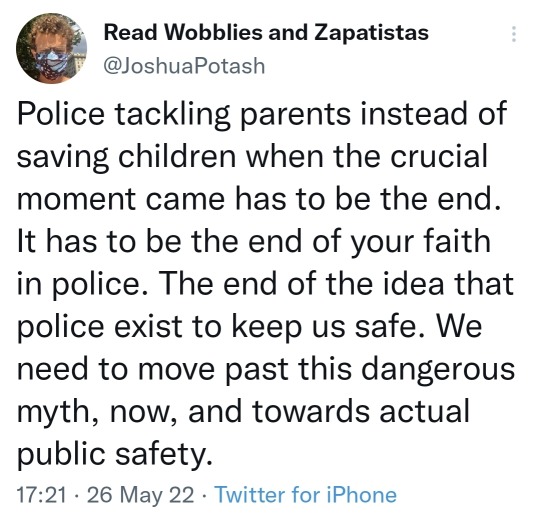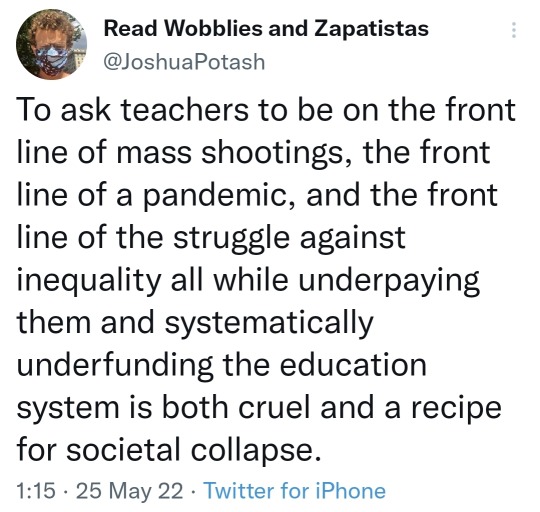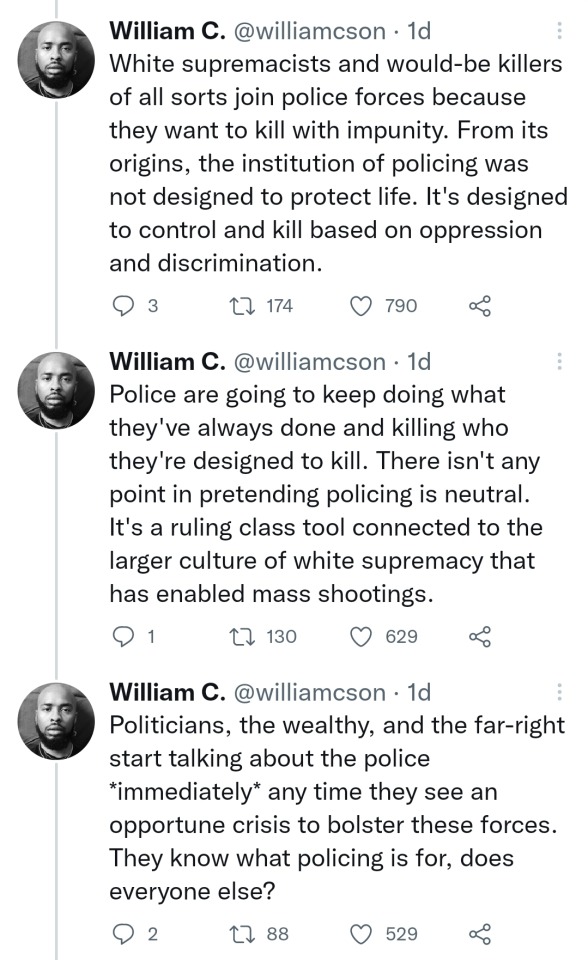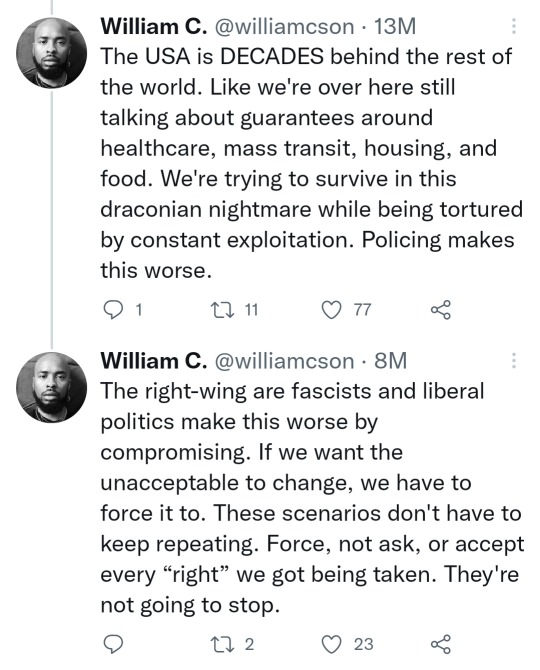#abolish the police
Text

#feminist#social justice#free palestine#palestine#free gaza#freepalastine🇵🇸#current events#settler violence#settler colonialism#settler terrorism#us foreign policy#us politics#us news#united states#us imperialism#israel is a terrorist state#israel is committing genocide#western imperialism#democrats#republicans#genocide joe#all cops are bastards#abolish the police#defund the cops#defund the police
529 notes
·
View notes
Text
“Hey, are you Eric Adams? FUCK YOU!”
Pricelessly funny: how the look on his face went from almost expecting a compliment, to OMG WTF?
Bless whoever that person is
29 notes
·
View notes
Text

#fuck cops#all cops are bastards#police violence#fuck the police#abolish the police#cops#anti capitalism#leftism#communism#socialism#twitter post#anarchy#defund the cops#police#law enforcement#arrest#police brutality#killed#policing
30K notes
·
View notes
Text
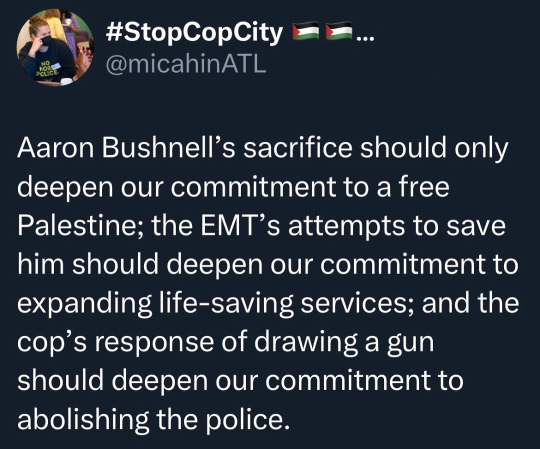
3K notes
·
View notes
Text

every clock is a cop
4K notes
·
View notes
Text
"IF YOU BUILD IT, WE WILL BURN IT"
11K notes
·
View notes
Text
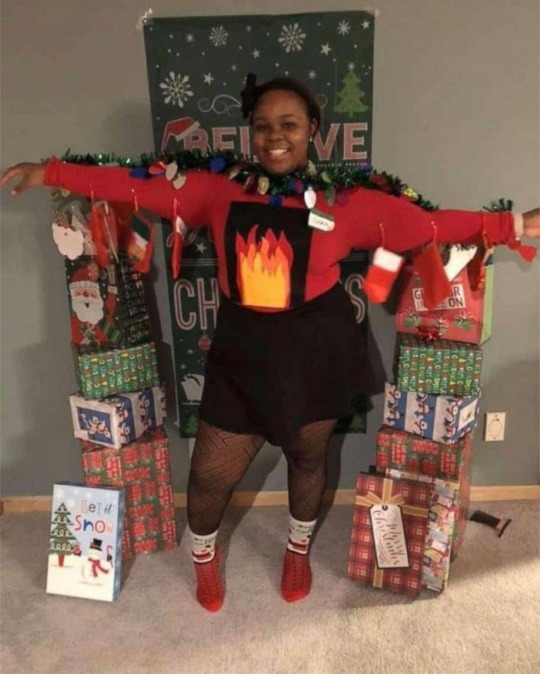
This was her FAVORITE time of year... She should be spending it with family... she should be be alive. I'm pissed she's not. I'm so so pissed. I'm hurt. on the verge of tears.
Please dont forget her face, her name, her smile, her caring soul.
She wanted to be a nurse. Wanted to help mothers and babies... And she never got to.
The world was a better place when she was in it...
Merry Christmas Breonna... Thinkin ab you...
#justice for breonna#breonna taylor#say her name#abolish the police#abolish capitalism#abolitionist#black lives fucking matter#protect black women#protect black girls#remember her always#merry christmas breonna#thinking ab her heavy today
3K notes
·
View notes
Text
How the NYPD defeated bodycams

Anything that can't go on forever will eventually stop. When American patience for racial profiling in traffic stops reached a breaking point, cops rolled out dashcams. Dashcam footage went AWOL, or just recorded lots of racist, pretextual stops. Racial profiling continued.
Tasers and pepper spray were supposed to curb the undue use of force by giving cops an alternative to shooting dangerous-seeming people. Instead, we got cops who tasered and sprayed unarmed people and then shot them to pieces.
Next came bodycams: by indelibly recording cops' interactions with the public, body-worn cameras were pitched as a way to bring accountability to American law-enforcement. Finally, police leadership would be able to sort officers' claims from eyewitness accounts and figure out who was lying. Bad cops could be disciplined. Repeat offenders could be fired.
Police boosters insist that police violence and corruption are the result of "a few bad apples." As the saying goes, "a few bad apples spoil the bushel." If you think there are just a few bad cops on the force, then you should want to get rid of them before they wreck the whole institution. Bodycams could empirically identify the bad apples, right?
Well, hypothetically. But what if police leadership don't want to get rid of the bad apples? What if the reason that dashcams, tasers, and pepper spray failed is that police leadership are fine with them? If that were the case, then bodycams would turn into just another expensive prop for an off-Broadway accountability theater.
What if?
In "How Police Have Undermined the Promise of Body Cameras," Propublica's Eric Umansky and Umar Farooq deliver a characteristically thorough, deep, and fascinating account of the failure of NYPD bodycams to create the accountability that New York's political and police leadership promised:
https://www.propublica.org/article/how-police-undermined-promise-body-cameras
Topline: NYPD's bodycam rollout was sabotaged by police leadership and top NYC politicians. Rather than turning over bodycam footage to oversight boards following violent incidents, the NYPD suppresses it. When overseers are allowed to see the footage, they get fragmentary access. When those fragments reveal misconduct, they are forbidden to speak of it. When the revealed misconduct is separate from the main incident, it can't be used to discipline officers. When footage is made available to the public, it is selectively edited to omit evidence of misconduct.
NYPD policy contains loopholes that allow them to withhold footage. Where those loopholes don't apply, the NYPD routinely suppresses footage anyway, violating its own policies. When the NYPD violates its policies, it faces no consequences. When overseers complain, they are fired.
Bodycams could be a source of accountability for cops, but for that to be true, control over bodycams would have to vest with institutions that want to improve policing. If control over bodycams is given to institutions that want to shield cops from accountability, that's exactly what will happen. There is nothing about bodycams that makes them more resistant to capture than dashcams, tasers or pepper spray.
This is a problem across multiple police departments. Minneapolis, for example, has policies from before and after the George Floyd uprisings that require bodycam disclosure, and those policies are routinely flouted. Derek Chauvin, George Floyd's murderer, was a repeat offender and had been caught on bodycam kneeling on other Black peoples' necks. Chauvin once clubbed a 14 year old child into unconsciousness and then knelt on his neck for 15 minutes as his mother begged for her child's life. Chauvin faced no discipline for this and the footage was suppressed.
In Montgomery, Alabama, it took five years of hard wrangling to get access to bodycam footage after an officer sicced his attack dog on an unarmed Black man without warning. The dog severed the man's femoral artery and he died. Montgomery PD suppressed the footage, citing the risk of officers facing "embarrassment."
In Memphis, the notoriously racist police department was able to suppress bodycam disclosures until the murder of Tyre Nichols. The behavior of the officers who beat Nichols to death are a testament to their belief in their own impunity. Some officers illegally switched off their cameras; others participated in the beating in full view of the cameras, fearing no consequences.
In South Carolina, the police murder of Walter Scott was captured on a bystander's phone camera. That footage made it clear that Scott's uniformed killers lied, prompting then-governor Nikki Haley to sign a law giving the public access to bodycam footage. But the law contained a glaring loophole: it made bodycam footage "not a public record subject to disclosure." Nothing changed.
Bodycam footage does often reveal that killer cops lie about their actions. When a Cincinnati cop killed a Black man during a 2015 traffic-stop, his bodycam footage revealed that the officer lied about his victim "lunging at him" before he shot. Last summer, a Philadelphia cop was caught lying about the circumstances that led to him murdering a member of the public. Again, the officer claimed the man had "lunged at him." The cop's camera showed the man sitting peacefully in his own car.
Police departments across the country struggle with violent, lying officers, but few can rival the NYPD for corruption, violence, scale and impunity. The NYPD has its own "goon squad," the Strategic Response Group, whose leaked manual reveals how the secret unit spends about $100m/year training and deploying ultraviolent, illegal tactics:
https://pluralistic.net/2021/04/07/cruelty-by-design/#blam-blam-blam
The NYPD's disciplinary records – published despite a panicked scramble to suppress them – reveal the NYPD's infestation with criminal cops who repeatedly break the law in meting out violence against the public:
https://pluralistic.net/2020/07/27/ip/#nypd-who
These cops are the proverbial bad apples, and they do indeed spoil the barrel. A 2019 empirical analysis of police disciplinary records show that corruption is contagious: when crooked cops are paired with partners who have clean disciplinary records, those partners become crooked, too, and the effect lasts even after the partnership ends:
https://journals.sagepub.com/doi/full/10.1177/2378023119879798
Despite the risk of harboring criminals in police ranks, the NYPD goes to extreme lengths to keep its worst officers on the street. New York City's police "union"'s deal with the city requires NYC to divert millions to a (once) secret slushfund used to pay high-priced lawyers to defend cops whose conduct is so egregious that the city's own attorneys refuse to defend them:
https://pluralistic.net/2021/03/26/overfitness-factor/#heads-you-lose-tails-they-win
This is a good place for your periodic reminder that police unions are not unions:
https://pluralistic.net/2020/07/28/afterland/#selective-solidarity
Indeed, despite rhetoric to the contrary, policing is a relatively safe occupation, with death rates well below the risks to roofers, loggers, or pizza delivery drivers:
https://pluralistic.net/2022/01/27/extraordinary-popular-delusions/#onshore-havana-syndrome
The biggest risk to police officers – the single factor that significantly increased death rates among cops – is police unions themselves. Police unions successfully pressured cities across American to reject covid risk mitigation, from masking to vaccinations, leading to a wave of police deaths. "Suicide by cop" is very rare, but US officers committed "mass suicide by cop union":
https://www.nytimes.com/2021/10/12/us/police-covid-vaccines.html
But the story that policing is much more dangerous than it really is a useful one. It has a business-model. Military contractors who turn local Barney Fifes into Judge Dredd cosplayers with assault rifles, tanks and other "excess" military gear make billions from the tale:
https://pluralistic.net/2020/07/10/flintstone-delano-roosevelt/#1033-1022
It's not just beltway bandits who love this story. For cops to be shielded from consequences for murdering the public, they need to tell themselves and the rest of us that they are a "thin blue line," and not mere armed bureaucrats. The myth that cops are in constant danger from the public justifies hair-trigger killings.
Consider the use of "civilian" to describe the public. Police are civilians. The only kind of police officer who isn't a civilian is a military policeman. Places where "civilians" interact with non-civilian law enforcement are, by definition, under military occupation. Calling the public "civilians" is a cheap rhetorical trick that converts a police officer to a patrolling soldier in hostile territory. Calling us "civilians" justifies killing us, because if we're civilians, then they are soldiers and we are at war.
The NYPD clearly conceives of itself as an occupying force and considers its "civilian" oversight to be the enemy. When New York's Civilian Complaint Review Board gained independence in 1993, thousands of off-duty cops joined Rudy Giuliani in a mass protest at City Hall and an occupation of the Brooklyn Bridge. This mass freakout is a measure of police intolerance for oversight – after all, the CCRB isn't even allowed to discipline officers, only make (routinely ignored) recommendations.
Kerry Sweet was the NYPD lawyer who oversaw the department's bodycam rollout. He once joked that the NYPD missed a chance to "bomb the room" where the NYPD's CCRB was meeting (when Propublica asked him to confirm this, he said he couldn't remember those remarks, but "on reflection, it should have been an airstrike").
Obvious defects in the NYPD's bodycam policy go beyond the ability to suppress disclosure of the footage. The department has no official tracking system for its bodycam files. They aren't geotagged, only marked by officer badge-number and name. So if a member of the public comes forward to complain that an unknown officer committed a crime at a specific place and time, there's no way to retrieve that footage. Even where footage can be found, the NYPD often hides the ball: in 20% of cases where the Department told the CCRB footage didn't exist, they were lying.
Figuring out how to make bodycam footage work better is complex, but there are some obvious first steps. Other cities have no problem geotagging their footage. In Chicago, the CCRB can directly access the servers where bodycam footage is stored (when the NYPD CCRB members proposed this, they were fired).
Meanwhile, the NYPD keeps protecting its killers. The Propublica story opens with the police killing of Miguel Richards. Richards' parents hadn't heard from him in a while, so they asked his Bronx landlord to check on him (the Richards live in Jamaica). The landlord called the cops. The cops killed Richards.
The cops claimed he had a gun and they were acting in self-defense. They released a highly edited reel of bodycam footage to support that claim. When the full video was eventually extracted, it revealed that Richards had a tiny plastic toy guy and a small folding knife. The officers involved believed he was suffering an acute mental health incident and stated that policy demanded that they close his bedroom door and wait for specialists. Instead, they barked orders at him and then fired 16 rounds at him. Seven hit him. One ruptured his aorta. As he lay dying on his bedroom floor, one officer roughly tossed him around and cuffed him. He died.
New York's Police Benevolent Association – the largest police "union" in NYC – awarded the officers involved its "Finest of the Finest" prize for their conduct in the killing.
This isn't an isolated incident. A month after the NYPD decided not to punish the cops who killed Richards, NYPD officers murdered Kawaski Trawick in his Bronx apartment:
https://pluralistic.net/2020/12/04/kawaski-trawick/#Kawaski-Trawick
The officers lied about it, suppressed release of the bodycam footage that would reveal their lies, and then escaped any justice when the footage and the lies were revealed.
None of this means that bodycams are useless. It just means that bodycams will only help bring accountability to police forces when they are directed by parties who have the will and power to make the police accountable.
When police leaders and city governments support police corruption, adding bodycams won't change that fact.

If you'd like an essay-formatted version of this post to read or share, here's a link to it on pluralistic.net, my surveillance-free, ad-free, tracker-free blog:
https://pluralistic.net/2023/12/13/i-want-a-roof-over-my-head/#and-bread-on-the-table

Image:
Cryteria (modified)
https://commons.wikimedia.org/wiki/File:HAL9000.svg
CC BY 3.0
https://creativecommons.org/licenses/by/3.0/deed.en
--
Tony Webster, modified
https://commons.wikimedia.org/wiki/File:Minneapolis_Police_Officer_Body_Camera_%2848968390892%29.jpg
CC BY-SA 2.0
https://creativecommons.org/licenses/by-sa/2.0/deed.en
#pluralistic#impunity#ccrb#nypd#abolish the police#acab#police#corruption#bodycams#body-worn cameras#propublica
3K notes
·
View notes
Text


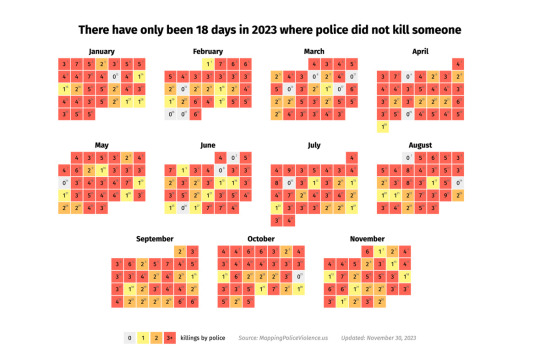

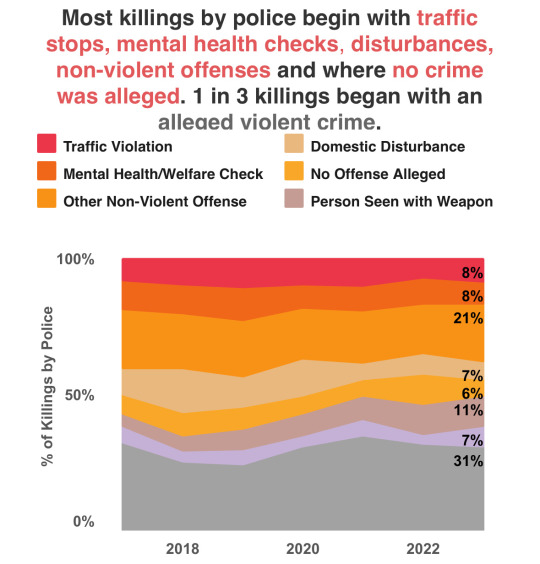

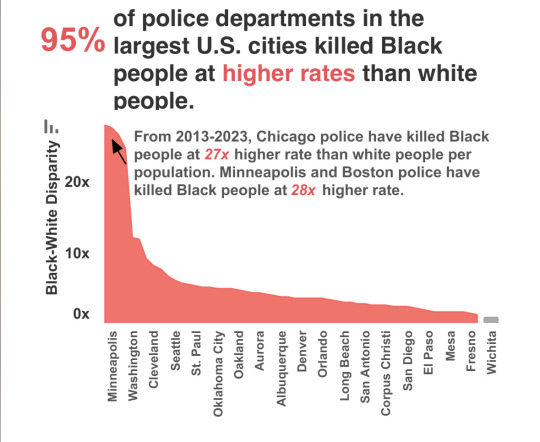
Much more interactive data here
#racism#criminal justice#government#racist#criminal justice system#acab#police state#abolish the police#the left#news#current events#police violence#violence
1K notes
·
View notes
Text

"This button gets people killed"
Sticker seen on a police emergency button in NYC
3K notes
·
View notes
Text
Remember that abolish slavery meant no more slavery at all. And abolish monarchy meant no more kings at all. They were thought to be unrealistic in their time, things that went agaisnt human nature, but those activists understood that they needed a zero tolerance policy on those things.
So when we say abolish police, that means no police. When we say abolish prisons, that means no prisons. When we say abolish capitalism, that means no capitalism. It isn't unrealistic. It can't be compromised.
#196#my thougts#leftist#leftism#anarchy#anarchism#anarchist#anarchocommunism#anarchopunk#communist#communism#prison abolition#abolish capitalism#abolish the police#abolish the monarchy#anticapitalist#anticapitalism#anti capitalist#antifa#anti colonialism#acab#fuck the police
381 notes
·
View notes
Text

#abolish the police#police brutality#tweet#rip twitter#anarchy#twitter post#anti capitalism#leftism#communism#socialism#fuck cops#fuck the police#police violence#homelessness#homeless#poverty#financial assistance#support#financial aid#usa news#usa politics#united states#geopolitics#united states of america#americans#america
1K notes
·
View notes
Text
The Vancouver School Board (VSB) may be prepared to “welcome” police officers back into schools next week, but it’s not a sentiment that’s shared by all.
On Thursday, the VSB held a press conference to reiterate its commitment to creating “safe, welcoming and inclusive spaces” for its learners, and said the new “reimagined” school liaison officer (SLO) program will advance school safety.
It also presented a new look for the SLOs that includes casual polo shirts, unmarked police vehicles and more discreet firearms.
Even with the lighter visual touch, however, the decision to bring police back into schools has been vigorously opposed by members of the Vancouver Police Department’s African Descent Advisory Committee. Members Sadie Kuehn and Parker Johnson said they’re concerned about potential harm to Black, Indigenous, racialized, queer, and disabled students.
“The (new look) doesn’t address the core issues of having young people — all young people — feel safe,” Kuehn, a former school trustee, told Global News on Friday.
Full article
This is exactly the problem with the white centrist approach to dealing with the problems around police. Putting them in new clothes in new cars with "discreet firearms" doesn't do a damn thing to protect people from the violent, oppressive force that is the police.
None of these changes address racial profiling, police brutality, or the fact that marginalized people (rightfully) feel unsafe around cops.
These changes are useless. Abolish the police.
(Commentary from Samira, @politicsofcanada )
#cdnpoli#canada#canadian politics#canadian news#canadian#vancouver#british columbia#BC#vancouver school board#vancouver police department#vancouver police#cops#police#police in schools#abolish the police#cops tw#police tw
798 notes
·
View notes
Text
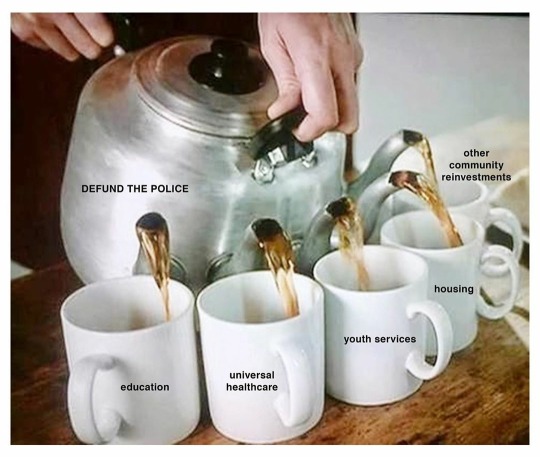
#black lives matter#defund the police#abolish the police#anti capitalism#socialism#universal healthcare#medicare for all
4K notes
·
View notes
Text

A cop anywhere is a threat everywhere.
No freedom exists where state enforcers feel comfortable, they are an ever-shifting and violent boundary. That boundary always surrounds, though its sharpness is only felt up close.
We are not free and we should not pretend to be.
257 notes
·
View notes
